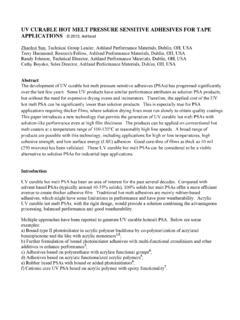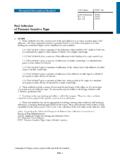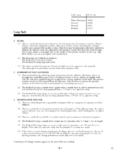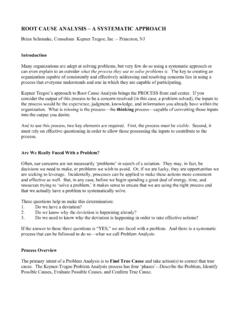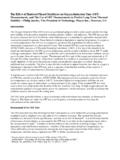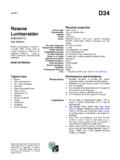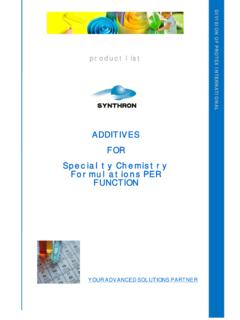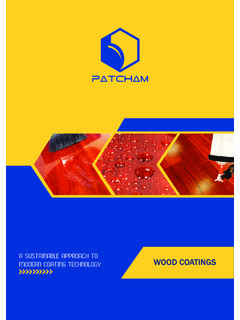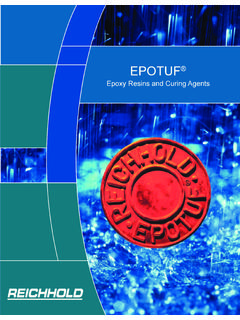Transcription of USE OF DIBENZOATE PLASTICIZERS IN PRESSURE-SENSITIVE …
1 USE OF DIBENZOATE PLASTICIZERS IN PRESSURE-SENSITIVE ADHESIVES William D. Arendt, Research Fellow; Emily McBride, Applications Chemist and Marianne Conner, Applications Chemist Emerald Kalama Chemical LLC Kalama Washington Abstract PLASTICIZERS extend the utility of the polymers in which they are used. Despite already having low Tgs, waterborne , solvent and hot melt PRESSURE-SENSITIVE adhesives can utilize PLASTICIZERS to enhance performance characteristics. Because of their polarity and range of compatibilities, DIBENZOATE PLASTICIZERS find wide usage in latex adhesives. In recent years, new blends and grades of dibenzoates have been developed to enrich the choices available to the formulator. These choices include a new DIBENZOATE triblend platform. Little has been published on the use of DIBENZOATE PLASTICIZERS in waterborne PRESSURE-SENSITIVE adhesives. The purpose of this paper is to show how PLASTICIZERS function with the soft polymers used in PSAs and to describe ways in which these PLASTICIZERS can be used and how they affect performance attributes.
2 The focus of this presentation will be on the newer DIBENZOATE products. Background PLASTICIZERS are normally used in polymeric systems to soften or to improve the processability of the composition. This is the basic definition of a plasticizer, with the caveat that the plasticizer needs to be at least partially compatible with the polymer being used. A measure of the effectiveness of a plasticizer can be the reduction of the glass transition of a polymer; the degree of suppression of the glass transition is also an indication of the compatibility of the plasticizer with the polymer and the other ingredients in the composition. The workability or processability of a plasticized composition may be more important than the actual softening of the polymer in the composition for some applications.(1) The use of PLASTICIZERS in PRESSURE-SENSITIVE adhesives (PSA) is well known.(2,3,4,5) The need for a plasticizer in a PSA certainly is driven by the type of adhesive as well as by the polymer in it.
3 However, waterborne acrylic based PSAs, solution borne PSAs and hot melt PSA s have been known to utilize PLASTICIZERS to enhance performance. For example, acrylic -based waterborne PSAs can use PLASTICIZERS to: Improve the wetting of the substrate and speed of wetting; Increase peel strength; Reduce the effective softening point of a tackifying resin and the combination will tackify more effectively. In addition to improving peel, the tack of the adhesive can be also improved. However, there is also the fact that PLASTICIZERS will reduce the holding power of the adhesive. PLASTICIZERS will also affect the performance of solution-borne acrylic adhesives in similar manners. Hot melt PSAs based on block copolymers (styrene types) are also likely to employ PLASTICIZERS . In the case of these compositions the PLASTICIZERS will be used to control the service type of PSA: to adjust the polymer/resin s overall Tg to meet the Dahlquist criteria for performance (which is true of all PSA adhesives).
4 (6, 7, 8, 9) The polymer type dictates which plasticizer will be of most use. In the case of acrylic polymers, polar PLASTICIZERS are a good choice. Classically, di-n-butyl phthalate (DBP), diisobutyl phthalate (DIBP), di-2-ethylhexyl phthalate (DOP), or diisodecyl phthalate have been PLASTICIZERS of choice. (3,4) Other plasticizer types including dibenzoates have been know to be used in these types of adhesives. In hot melt PSAs, oils such as aliphatic, cycloaliphatic and aromatic types are employed as PLASTICIZERS . (10, 11) Performance is dictated by compatibility and lack thereof. If a plasticizer is less efficient, more can be added; this is sometimes an advantage if more plasticizer use is desired. The type of oil is selected based on total performance needs. Polar PLASTICIZERS can be used in block copolymer but mostly (with one exception) what is used is some type of oil. A significant amount of literature is published on the use of oils in PSAs but not a lot are available on the use of polar type PLASTICIZERS in any PSA.
5 (10) Even less literature is available on the use of dibenzoates in PSAs. With that in mind, the focus of this paper will be on the polar PSA polymers as that is the most likely significant use area for dibenzoates. The class of phthalate esters has environmental and health concerns. If adequate replacements are available, non-phthalates are the PLASTICIZERS of choice. As mentioned earlier, dibenzoates have been used in acrylic PSAs in the past. They are certainly non-phthalates but before that was important they were polar specialty performance PLASTICIZERS . As a matter of fact, dibenzoates are the general purpose PLASTICIZERS of choice for waterborne adhesives based on polyvinyl acetate homo and copolymers. (1) Historically, dibenzoates have been known since the 1920s. The first patent listing use of dibenzoates in polyvinyl chloride compositions was in the late 1930s. Since then the DIBENZOATE family has grown. The first two dibenzoates of importance were: Diethylene glycol DIBENZOATE , and Dipropylene glycol DIBENZOATE .
6 These still are important PLASTICIZERS , and blends of the two are commonly used. However, newer blends and other dibenzoates and benzoates have gained in use as they have been developed to keep pace with the industry. Most recently, two new blends of dibenzoates and a new grade of propylene glycol DIBENZOATE have been introduced for adhesives and other applications. They are: A blend of diethylene glycol DIBENZOATE , dipropylene glycol DIBENZOATE and propylene glycol DIBENZOATE , and A blend of diethylene glycol DIBENZOATE and dipropylene glycol DIBENZOATE , very rich in diethylene glycol DIBENZOATE and manufactured for efficiency. These DIBENZOATE products have been investigated extensively for use in latex adhesives and the results of those studies are demonstrated elsewhere(1). The purpose of this study is to demonstrate how dibenzoates function in waterborne acrylic PSAs and will focus on the use of the new DIBENZOATE triblend.
7 Experimental Introduction Two PSA acrylic waterborne polymers were selected to be the basis of the adhesives of this study. One had a Tg of about -20 C and the other was about -40 C. Tackifier dispersions were selected for each evaluation segment. The plasticizer selected for the study was the triblend of DIBENZOATE PLASTICIZERS listed above which is abbreviated 975P. As there are many possible combinations, a DOE (design of experiments) approach was selected to gain a better understanding of how the polymer, resin and plasticizer interact. It is true that initially a screen experiment is often the best approach to start the DOE process. However, based on what is already known about plasticizer use in PSAs it was felt that a mixture design was the best approach. (12) Design Expert 8 made by Stat Ease was the software selected for the study. A mixture design, Optimal D, quadratic, was selected. The design variables were: Polymer: 60 to 100% maximum were the limits selected; Tackifier dispersion: 0 to 30% maximum; Plasticizer: 0 to 10% maximum.
8 These design variables were weight percent on the wet polymer. The response variables were: Viscosity: initial, 1 day, 3 day; pH; Rolling ball tack; Probe tack; Quick stick; 180 peel; Loop tack, and Holding power. Details of the experimental are listed in Appendix 1. The actual design is as follows: Table 1 DOE Design Variables Run Number Polymer Plasticizer Tackifier 1 2 3 4 5 6 7 8
9 9 10 11 12 13 14 15 16 The DOE used was the same for both systems.
10 In the case of the lower Tg polymer, the other ingredients in the formulation were hidden but in the case for the higher Tg polymer only the polymer, plasticizer and resin dispersion were employed in the adhesive. As stated above, it should also be pointed out again that the polymer and the resin dispersion were entered in as wet rather than dry ingredients into the DOE, and also note that in the mixture design the design variables were entered in as adding to one, not weight or %. Results and Discussion The results of the evaluation DOEs are listed in Tables 2 and 3 in Appendix 2. It is clearer to illustrate the data by reviewing the figures from the DOE experiment. The data will be discussed below by test. To make it simpler to observe the, 40 C Tg and 20 C Tg polymer data will be illustrated side by side. The first test data are on the viscosity of the adhesives, as shown in Figures 1a and 1b. Figure 1a Viscosity of the 40 Tg Polymer Figure 1b Viscosity of the 20 Tg Polymer Because of the restriction of using black and white in the presentation paper it is difficult to discern the flow of the contour maps.
